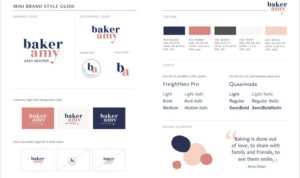Developing Brand Guidelines sets the stage for this enthralling narrative, offering readers a glimpse into a story that is rich in detail with american high school hip style and brimming with originality from the outset.
Brand guidelines are the blueprint for creating a strong and recognizable brand image, influencing how a company is perceived by its audience. Let’s dive into the key components and strategies that make up these essential guidelines.
Importance of Developing Brand Guidelines
Having clear brand guidelines is crucial for a company to maintain a consistent and recognizable brand identity across all marketing channels. It serves as a roadmap for employees, ensuring that everyone is aligned on how the brand should be represented.
Impact on Branding Efforts
- Consistent Visual Identity: Brand guidelines help maintain a consistent look and feel across all branding materials, such as logos, color schemes, and typography.
- Messaging Cohesion: By outlining key brand messages and tone of voice, guidelines ensure that all communication is in line with the brand’s values and personality.
- Improved Brand Recognition: When customers encounter consistent branding elements, they are more likely to remember and recognize the brand in the future.
Building Trust with Customers, Developing Brand Guidelines
- Reliability: Consistent branding instills a sense of reliability and professionalism, making customers feel confident in the company’s products or services.
- Authenticity: When a brand presents itself consistently, it conveys authenticity and transparency, which are crucial for building trust with customers.
- Positive Perception: Customers are more likely to trust a brand that appears cohesive and well-defined, as it reflects a commitment to quality and customer satisfaction.
Components of Brand Guidelines
Defining brand guidelines involves outlining key elements that help maintain consistency and coherence in brand communication. From brand voice and tone to visual elements like logos, color palettes, and typography, each component plays a crucial role in shaping the overall brand identity.
Brand Voice and Tone
Brand voice refers to the personality and style of communication that a brand uses to connect with its audience. It sets the tone for all brand messaging, ensuring that it resonates with the target market. Consistency in brand voice helps build trust and recognition among consumers, making it essential to define and document in brand guidelines.
Visual Elements
Visual elements such as logos, color palettes, and typography are integral parts of a brand’s visual identity. Logos serve as the primary symbol of a brand, while color palettes and typography contribute to the overall look and feel of brand assets. By specifying guidelines for these visual elements, brands can ensure a cohesive and memorable brand presence across all touchpoints.
Creating a Brand Personality: Developing Brand Guidelines

Defining a brand’s personality in guidelines is all about establishing the characteristics, values, and traits that make the brand unique and relatable to its target audience. It involves identifying the brand’s voice, tone, and overall identity to ensure consistency in all communication and marketing efforts.
Expressing Brand Personality
- Through Social Media: Brands like Wendy’s and MoonPie use witty and humorous content to showcase their playful personalities on platforms like Twitter.
- Visual Identity: Companies like Apple and Nike convey their innovative and forward-thinking personas through sleek and modern design elements in their logos and marketing materials.
- Customer Interactions: Brands like Zappos and Southwest Airlines build their friendly and customer-centric personalities through exceptional customer service and personalized interactions.
Influencing Customer Perception and Loyalty
Brand personality plays a crucial role in shaping how customers perceive a brand and their overall loyalty towards it. When a brand consistently embodies its personality traits across all touchpoints, it creates a strong emotional connection with customers. This connection leads to increased brand trust, loyalty, and advocacy as customers resonate with the brand’s values and identity on a deeper level.
Implementing Brand Guidelines Across Platforms

When it comes to implementing brand guidelines across various platforms, consistency is key. This means ensuring that your brand’s visual elements, messaging, and tone are uniform no matter where your audience interacts with your brand.
Strategies for Consistent Brand Representation
- Provide detailed brand guidelines to all team members involved in content creation and marketing.
- Utilize templates and design assets that adhere to brand standards.
- Regularly review and audit content to ensure alignment with brand guidelines.
- Use a centralized asset management system to store and distribute brand assets.
- Train all employees on the importance of brand consistency and how to implement guidelines effectively.
Challenges in Implementing Brand Guidelines
- Resistance from team members who may not see the value in strict adherence to brand guidelines.
- Difficulty in maintaining consistency across multiple platforms and channels.
- External factors such as platform limitations or changes in industry trends.
Tips for Adapting Brand Guidelines to Different Marketing Channels
- Understand the unique requirements and audience preferences of each platform.
- Customize content while still maintaining core brand elements.
- Utilize analytics to track performance and adjust strategies accordingly.
- Stay updated with industry trends and platform changes to ensure brand relevance.



